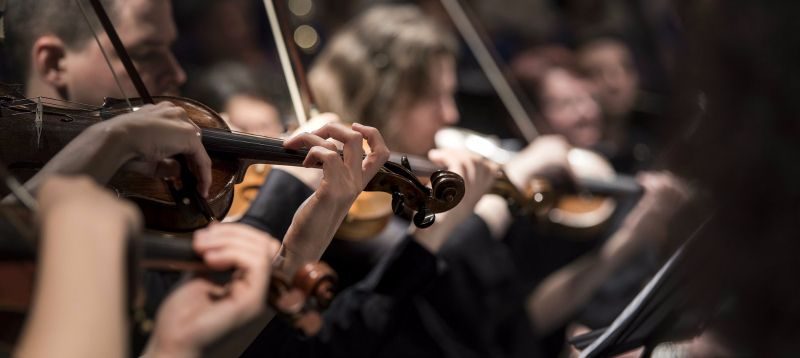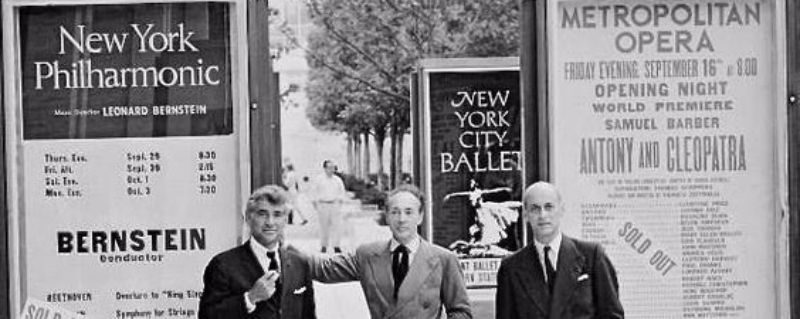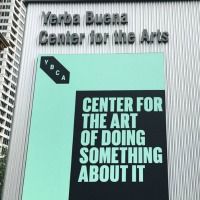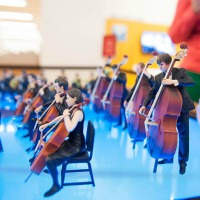Marina Harss talks with company artistic director Janet Eilber and rehearsal director Denise Vale about recreating the stark 1931 piece Primitive Mysteries – and with PeiJu Chien-Pott, who’s dancing Graham’s own role and says it’s the hardest one she’s ever done.
Tag: 02.16.17
‘White Guy For Rent’ – Playing Random Foreigners To Help Chinese Developers Sell Condos
During the big real estate bubble a few years ago that led to China’s now-notorious “ghost cities,” expats like David Borenstein found work as what Chinese called a “laowai-for-rent” – appearing at real estate sales events pretending to be a foreign businessman or musician or athlete in order to make the development look international and important. Borenstein tells Linda Poon what it was like.
Did ‘Goodnight Moon’ Have A Sequel? Yes, Sort Of
In 1950, Margaret Wise Brown wrote, and put away, two fragments that Sarah Lyall describes as “part variation on, part expansion of” her 1944 children’s book , which later became a worldwide bestseller. Lyall tells how those two fragments were found and combined by an editor and will be published this year.
Google Has Created A Bot To Play Duets With You
“Google’s latest artificial intelligence experiment is a music-playing piano bot that digests whatever keyboard melodies you give it and tries to respond in kind.” But does it succeed in responding in kind? Nick Statt tries it out. (includes video)
Anish Kapoor To Put A Deep Black Whirlpool In Brooklyn Bridge Park
New York City’s Public Art Fund in New York will install Kapoor’s Descension – a funnel of black-colored water that spirals down into the ground – in Brooklyn Bridge Park this summer. (How many think-pieces do you suppose we’ll get comparing it to the 9/11 Memorial?)
Tom Morris: Artistic Leadership Is About Vision And People, Not Buildings
As part of our Artistic Leadership Series, Tom Morris responds to Joe Horowitz’s Lincoln Center essay: “We live in an era of growing niche audiences for music – institutions cannot address that reality if frozen in fancy yet over-large and rigid concert halls that trap them artistically, financially and organizationally… Could it be that doing less but better is a more promising strategy?”
Artistic Leadership Is About People And Vision, Not Buildings

By Thomas W. Morris
I recall clearly seeing the picture of Bing, Bernstein and Balanchine in 1966, and remember well the promise of creative artistic explosion with the realization of the Lincoln Center dream with leaders, as Joseph Horowitz says, “poised to drive their celebrated companies to great heights, buoying by an unprecedented American cultural complex.“
We have to remember that at the time, Lincoln Center was the first in new cultural facilities that subsequently engulfed America over the next 50 years. Along with the huge Ford Foundation investment in orchestras also at the time, everyone was very caught up with equating “bigger” with “better”. What happened, and why were the aspirations so flawed?
Albeit with the benefit of hindsight, there were numerous erroneous assumptions underlying the Lincoln Center dream of 1966:
- The assumption that a glittering building is an enabling prerequisite for greater creativity: New and glittering buildings have predictable consequences that need sober consideration in thinking about the future:
- Yes, the glamor of new and audience-friendly halls can be highly attractive in building audience and excitement, as Walt Disney Hall and the Elbe Philharmonie are currently doing. However, even if operational and architectural success were always guaranteed (which they are not), novelty gives way eventually to routine, and therefore is not an assured long-term strategy.
- While glamorous new buildings can be attractive to audiences in the short-run, they can divert attention from the far more important priority of investing more in supporting what is being produced in the spaces. The Philadelphia Orchestra is still rebuilding a sufficient endowment because of the diversion of funds in the 1990’s away from endowment fundraising and into the building of the Kimmel Center.
- The assumption that a cultural center of multiple institutions will lead to a creative synergy far greater than the sum of its constituents:
- Institutions in close proximity do not assure that they will plan, create and produce together in an idealistic atmosphere of harmony, openness and creativity. That takes a commitment by leaders to think and act beyond the mere challenges of their own institutions, and an organizational structure that encourages and rewards cooperation, not dilutes it. Cooperative artistic projects between institutions require the willingness of leaders to subvert their own goals and aspirations to the mutual advantages of planning with others. Even as Lincoln Center began in 1966, there was never a time when Bing, Bernstein and Balanchine – strong leaders all – were willing or able to do this. It was always each man/institution for himself.
- Additionally in the case of Lincoln Center, the institutionalization of the so-called “mother-ship” actually created an additional competitor to the resident companies, also on its own quest for audiences for its own productions, philanthropic support for its overhead and projects, and lay leadership for its governance structures.
- The assumption that bigger is better: The argument can be persuasively made that the sheer size of the Met and the Philharmonic in 1966, to say nothing of how they have grown since then, has not led to greater stability and creativity today.
- Both organizations are still plagued with substantial structural deficits, are still operating independent creatively of each other, are still starved for full houses, and are still fixated artistically on a canon of past musical works.
- Increased scale of operation is usually equated with increased lack of nimbleness and greater inertia – it is easier to simply continue doing what you have been doing, and to do more of it.
- New buildings are more expensive to operate than older ones, a fact that most organizations fail to adequately anticipate in moving into newer structures. The result is upward pressures on operating costs just as anticipated bumps in earned revenues generated by the new hall excitement are being enjoyed. Such increases in operating costs do not decline over time, unlike more transitory increase in the earned revenues as novelty declines.
- New buildings can become straightjackets in how they limit flexibility in program structure, whether that means perpetuation of the proscenium concept separating performers and audience, or the hidden real direct and indirect costs of making format adjustments depending on what is being presented. Think of the enormous scale of the MET hall, and how, despite the promise of greater ticket sales from a greater capacity, that enormity has limited the type of opera that can be effectively presented there. Think of the enticing prospect of reconfigurations at Carnegie Hall’s Zankel Hall, a flexibility that was doomed by the extravagant cost of changing the hall configuration to fit what was being presented
- The assumption that merely hiring a glamorous and able leader will lead to greater creativity:
- Institutions clearly require strong and visionary leadership, leadership that is shared throughout the institution and acted upon strategically and continuously. A single strong leader, while necessary, is not sufficient to effectuate change alone.
- Additionally, effective leaders need to persevere over a long enough tenure to empower the motor of continuing progress. In the case of Bernstein, for all the promise of in 1966, he shortly thereafter departed to be better recognized in Europe as a master conductor of the traditional canon, leaving the Philharmonic. His successor, Pierre Boulez, despite his intellectual center, lacked Bernstein’s glamor and theatricality and didn’t last long enough to effectuate lasting progress as audiences and donors pined for a return to the gold age of traditional canon.
The crucial lesson to be learned is that artistic viability is cannot depend on the above erroneous assumptions, but rather must be focused on instilling creativity in the art form, and true artistic creativity reflects the social environment in which it exists. The failure of the MET and Philharmonic, is, as Joe Horowitz says, “they retain a culture of performance remote from both the creative act and the American experience.” It is crucial not to confuse this with successful innovations from the MET such as Super Titles and the HD Television Screenings, both immensely important and successful initiatives that have changed the face of opera, but both of which are rooted more in making the canon more accessible and available to wider audiences. That is not creating living art.
It seems to me that essential for a lively future for the art of music are variables of the concert experience – venue, concert format, concert time, concert length, program structure, price, and marketing strategies – and making choices of such variables based on the art. We live in an era of growing niche audiences for music – institutions cannot address that reality if frozen in fancy yet over-large and rigid concert halls that trap them artistically, financially and organizationally. How hopeful that the Philharmonic has started to right-size certain performances in non-standard spaces around the city through its creative Biennale, actively embracing the community through other venues, other performing institutions and a wider range of musical forms. It is also advocating a more flexible performance space for its to be renovated Geffen Hall, while the MET for years has toyed with a more nimble and flexible Piccolo Met, yet to be realized.
Could it be that doing less but better is a more promising strategy?
Thomas W. Morris is the former executive director of the Boston Symphony and The Cleveland Orchestra. He is currently artistic director of the Ojai Music Festival
The Secret Hoard Of Looted Art From Cornelius Gurlitt’s Apartment Is Finally Going On View
Gurlitt, who died in 2014, was the son of one of the dealers Goebbels chose to sell confiscated “degenerate” artworks abroad. He left his entire collection – about 1,500 works inherited from his father (including Picasso, Matisse, Chagall, Monet, Kokoschka, Courbet, Dürer, Canaletto, and others) worth an estimated billion dollars – to the Bern Art Museum, which is about to exhibit it in partnership with Bonn’s Bundeskunsthalle.
Culture On a Hill – Did America’s Performing Arts Center Model Lead To A Dead End?
This week we’re publishing Joe Horowitz’s essay “Bing, Bernstein, and Balanchine Fifty Years Later” looking at the opening of Lincoln Center 50 years later. Lincoln Center was built to be a launch pad for American performing arts; instead perhaps it may have been a cul de sac. Along with Joe’s essay, we offer several response essays.
Culture On a Hill – Did America’s Performing Arts Center Model Lead To A Dead End?

Fifty years ago Lincoln Center opened in New York City. Unquestionably, the project was a success for the neighborhood, sparking a rejuvenation of Manhattan’s upper West Side and providing needed homes for the city’s major performing arts companies. It was also an influential idea – creating a campus for the performing arts and drawing attention to the arts as a critical mass of excellence – and it set off a generation of new performing arts centers around America.
So influential has the Lincoln Center idea been, that fifty years on it seems important to weigh the idea against its impact on American artistic life. This is probably unfair. Lincoln Center was built as an artistic home and this it has been and continues to be. It has also been one of the premiere showcases of American cultural life and has presented most of the important artists of the past 50 years. Jobs well done.
But we’d like to consider Lincoln Center the idea, in the bigger American cultural context. Joseph Horowitz, as a fellow at NYU’s Center for Ballet and the Arts has written an essay that suggests that Lincoln Center, which re-situated the New York Philharmonic, The Metropolitan Opera, and New York City Ballet with the aim of becoming a launching pad for a new era of America’s performing arts, instead represents a kind of cul de sac, and that artistic leadership in America has struggled ever since. We publish his essay here along with five responses to his provocation.
Additionally, on Friday, February 17, 2017 at 1:30PM (Mountain Time), we will live-stream a discussion from the University of Texas at El Paso and the Copland in Mexico Festival. Check back here to watch or catch it in the archive later.
THE ESSAY
 Lincoln Center Snapshot: Bing, Bernstein, and Balanchine Fifty Years Later – By Joe Horowitz
Lincoln Center Snapshot: Bing, Bernstein, and Balanchine Fifty Years Later – By Joe Horowitz
With the arrival of the Metropolitan Opera at Lincoln Center fifty years ago, the three main institutional constituents were put in place. New synergies were expected to ignite higher achievements at the Met in tandem with the New York Philharmonic and New York City Ballet. In retrospect, it is unsurprising that this never happened. The twenty-first century poses exigent challenges to performing arts institutions – challenges that may be more readily met where “bigger is better” assumptions were never implemented.
RESPONSES
 Is artistic leadership at America’s arts institutions lacking? Is this at the root of declining relevancy? – By Diane Ragsdale
Is artistic leadership at America’s arts institutions lacking? Is this at the root of declining relevancy? – By Diane Ragsdale
Perhaps now is the time to prioritize artistic vision over business acumen; to grant artists primacy within the arts institution; and to shift attention from wealthy donors to the community-at-large. Perhaps now is the time to embrace the paradox of being Public Arts Institutions: a part of society—but a part which must remain apart in order to fulfill its role.
 Artistic Leadership Is About Vision And People, Not Buildings – By Thomas W. Morris
Artistic Leadership Is About Vision And People, Not Buildings – By Thomas W. Morris
We live in an era of growing niche audiences for music – institutions cannot address that reality if frozen in fancy yet over-large and rigid concert halls that trap them artistically, financially and organizationally… Could it be that doing less but better is a more promising strategy?
 Is The Institutionalization Of Our Arts A Dead End? – By Douglas McLennan
Is The Institutionalization Of Our Arts A Dead End? – By Douglas McLennan
While there is an argument to be made for clustering together arts organizations and cultural buildings, the idea has to be animated in some way. Why should these organizations physically be together? Is it about art or about buildings? If it’s about buildings – creating a kind of critical mass of cultural activity that benefits by proximity – then the art comes to be defined by the buildings and how they’re used.
 An Experiment for American Dance? – By Deborah Jowitt
An Experiment for American Dance? – By Deborah Jowitt
And that was that for the American Dance Theater: a valiant, unsustainable effort to identify the New York State Theater as welcoming to other New York City companies beside New York City Ballet (and possibly to introduce modern dance to a larger audience). The idea of a repertory company that would present the works of various contemporary choreographers in a theater in which none of them could afford to perform with their own companies (or could have filled) was admirable. It was also unworkable. For whatever reason, shared seasons materialize either.
 A Museum Culture of Symphony Orchestras? – David Gier
A Museum Culture of Symphony Orchestras? – David Gier
We have indeed created a museum culture out of this art form, one which is perceived as irrelevant for many reasons, an unnecessary result of a focus on the “masterpieces” we all know and love at the expense of the creation of our own voice.
